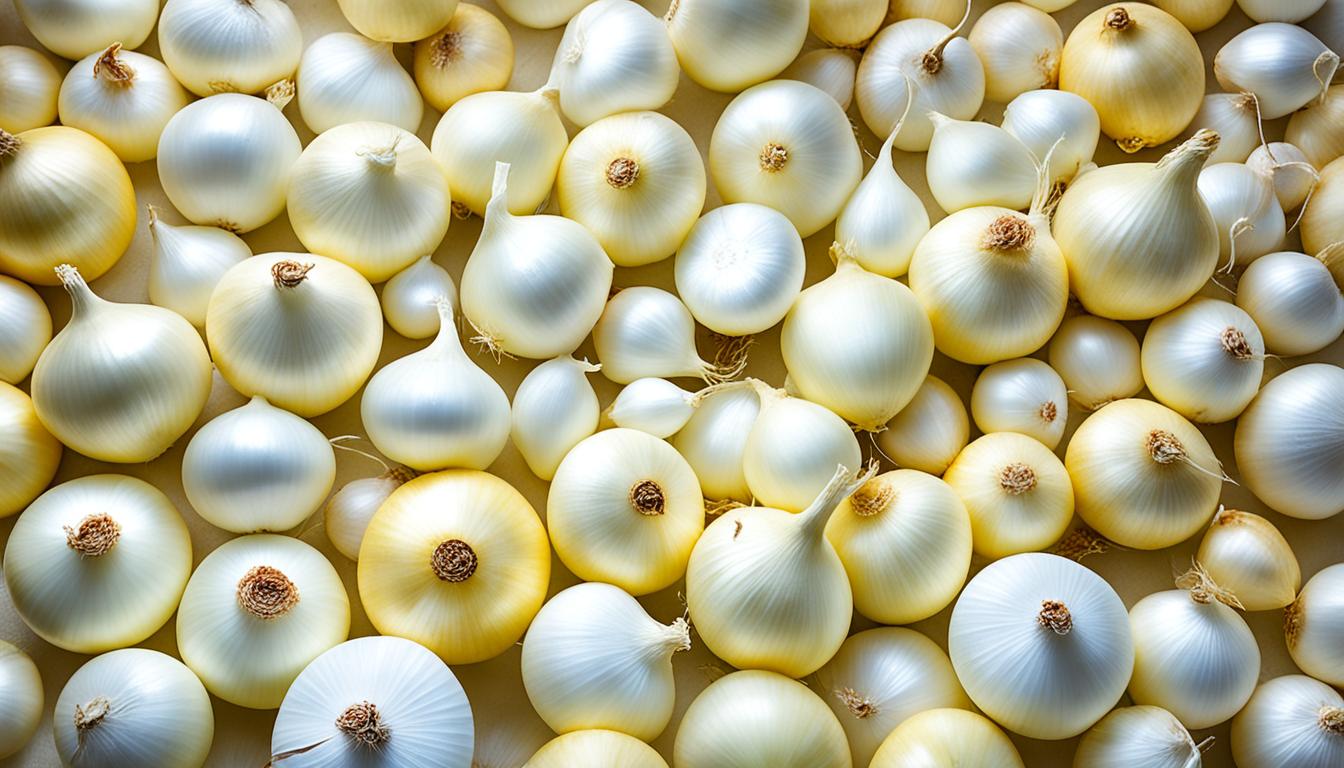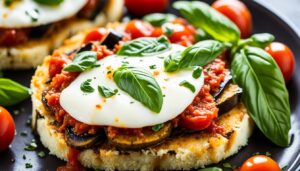White onions and yellow onions bring unique tastes to the table. They are well-loved in the food world. Knowing their differences can make your food stand out and improve your cooking.
Key Takeaways:
- White onions and yellow onions have different flavor profiles and culinary uses.
- White onions are milder and slightly sweet, making them ideal for raw preparations.
- Yellow onions have a stronger flavor and hold their shape better when cooked.
- Both onion varieties offer nutritional benefits and can be used interchangeably in most recipes.
- Consider the specific dish and desired flavor when choosing between white onions and yellow onions.
The Flavor and Aroma of Onions
White onions and yellow onions have their own unique tastes and smells. These differences can change how a meal tastes.
White onions are milder and a bit sweet. They are not as strong as yellow onions. This makes them perfect for recipes needing a soft onion flavor. When cooked, white onions mix well into the dish, making the flavor smooth.
Yellow onions, however, have a stronger taste. They add a powerful and rich flavor to cooked meals. When cooked, they keep their shape and distinct taste.
Yellow onions also have a stronger smell. This strong aroma makes dishes richer and more enjoyable.
If you want a softer, sweeter taste, choose white onions. For a bold onion flavor and aroma, go for yellow onions. It depends on what your recipe needs.
Now, let’s look at the best ways to use white and yellow onions in the next section.
Best Uses for White Onions
White onions are incredibly versatile and can be used in many dishes. They add a subtle and elegant flavor. Perfect for raw dishes like salads, salsas, and sandwiches, they make your meals exciting.
They’re also great for quick cooking methods such as stir-frying or grilling. Their mild flavor goes well with many ingredients. Use white onions in stir-fries or kebabs to discover their unique taste.
Here are some popular white onion recipes to inspire your culinary creativity:
- White Onion and Avocado Toast
- White Onion and Tomato Salad
- Garden Fresh Salsa with White Onion
- White Onion and Cucumber Sandwich
- White Onion Pasta Salad
Explore the endless possibilities of cooking with white onions. They can enhance your recipes with their sophisticated flavor. From light summer salads to flavorful grilled dishes, white onions are a key ingredient that boosts your cooking.
Benefits of Yellow Onions
Yellow onions bring a lot of flavors to cooked dishes. They are strong in taste and keep their shape well in cooking. This makes them great for soups, stews, and braises. They are a key ingredient in many Mexican recipes.
One great thing about yellow onions is they caramelize when cooked slowly. This brings out a rich, sweet flavor. Caramelized onions can upgrade sauces, sandwiches, pizzas, burgers, and steaks.
They also make soups and stews more delightful. Yellow onions add a savory flavor that makes simple meals comforting. They stay firm in long-cooked dishes, making them perfect for slow-cooked recipes.
“Yellow onions are a staple in many kitchens due to their ability to add flavor and complexity to cooked dishes.”
French onion soup is a famous dish made with yellow onions. The onions are caramelized slowly and then cooked with broth, herbs, and cheese. This soup is loved all over the world.
Beef stew is another dish that shows off yellow onions. The onions are browned and then cooked with beef, veggies, and spices. It’s a rich, tasty stew great for cold nights.
Yellow Onion Nutrition
Yellow onions are nutritious. They are low in calories and fat which makes them good for a balanced diet. They also have fiber, vitamin C, potassium, and manganese.
Plus, onions have antioxidants like quercetin. Antioxidants can help reduce inflammation and boost the immune system. This adds to the health perks of using onions in your meals.
Yellow Onion Recipe Ideas
Want to try using yellow onions in your cooking? Here are some recipe ideas:
- French Onion Soup – Enjoy the rich flavors of caramelized yellow onions in this classic soup.
- Beef Stew – Add depth and heartiness to your stew with sautéed yellow onions.
- Mexican Enchiladas – Use yellow onions as a flavorful filling for these traditional enchiladas.
- Stir-Fried Vegetables – Sauté thinly sliced yellow onions with your favorite vegetables for a quick and delicious side dish.
- Roasted Root Vegetables – Combine yellow onions with carrots, potatoes, and other root vegetables for a flavorful roasted medley.
Yellow onions can make your dishes taste better. They are great for making stews better or adding flavor to stir-fries. Yellow onions are essential for any cook.
Nutritional Profile of Onions
Both white and yellow onions are packed with health benefits. They fit well into a healthy eating plan. Let’s explore the nutritional value of these versatile veggies.
Calorie and Fat Content
White and yellow onions are low in calories. This makes them perfect for weight watchers or those maintaining a healthy body. A 100-gram serving of white onions has about 40 calories. The same size serving of yellow onions has about 60 calories. Plus, these onion types have almost no fat, adding to their nutritional value.
Dietary Fiber
Onions are rich in dietary fiber. This is key for good digestion and a healthy gut. A 100-gram serving of white onions has about 1.7 grams of fiber. The same serving of yellow onions has about 2.1 grams. Adding these fiber-filled veggies to your diet can boost digestive health.
Vitamin C
Vitamin C is vital. It supports a healthy immune system and aids in collagen production. Both white and yellow onions are good sources of it. A 100-gram serving of white onions offers about 7.4 milligrams of Vitamin C. Yellow onions provide about 7.6 milligrams in the same serving size.
Minerals
Onions come loaded with essential minerals. They have a lot of potassium, vital for healthy blood pressure. Onions also have calcium, iron, magnesium, and zinc. These minerals support various bodily functions.
Antioxidants and Other Health Benefits
Onions are full of antioxidants like quercetin. Such antioxidants offer many health benefits. Quercetin fights inflammation and might protect against heart disease and some cancers. Onions also have compounds that could boost the immune system and overall wellbeing.
“Adding white and yellow onions to your diet gives you essential nutrients and plant-based compounds. These promote good health.”
Summary
White and yellow onions have a lot in common nutrition-wise. They’re low in calories and rich in dietary fiber, vitamin C, and minerals. Their antioxidants and health benefits make them great for a balanced diet. Whether you like white onions’ mild taste or the strong flavor of yellow ones, adding them to meals can help your overall health.
Selecting and Storing Onions
Choosing the best onions is key to great tasting dishes. Whether you love white onions for their mildness or prefer the robust flavor of yellow onions, these tips can guide you. They help you pick the right onions for your meals.
Choosing the Best Onions
Keep these tips in mind when you’re picking onions:
- Look for onions that feel firm and are heavy. This means they are fresh and not old.
- Don’t pick onions with bruises or soft spots. These signs could mean the onion is damaged or spoiled.
- Check the skin of white and yellow onions. It should be dry and papery. Avoid onions with sprouts because they may not taste as good.
By picking the best onions, you make sure they add the best taste and texture to your meals.
Storing Onions
Keeping your onions fresh is important:
- Onions should be kept in a cool, dry place. Keep them away from heat and sunlight to prevent them from going bad.
- Use a mesh bag or basket for your onions. This allows air to flow around them. Do not use sealed plastic bags as they can cause the onions to spoil.
- If you didn’t use a whole onion, store the rest in your fridge. Put it in an airtight bag or container to keep it fresh and stop it from smelling.
- Using glass containers is best for keeping onions in the fridge. They help to keep the smell of onions contained.
With these storage tips, your onions will stay fresh longer. Now, they’re ready whenever you need them for a recipe.
Cooking Tips and Tricks
Working with onions can make your dishes taste better and prep easier. Here are some techniques you might like:
Soaking Onions to Minimize Pungency
Soaking onions can make them taste smoother. Try soaking them in water for 30 to 60 minutes before using them. This can make them less sharp and better for your meals.
Preventing Tears While Cutting Onions
Cutting onions often makes us tear up. But there are ways to avoid this. First, cut off the ends and rinse the onion under water. This reduces the tear-causing gas. Wearing goggles or cutting onions near running water also helps.
Onion Slicing Techniques
Different dishes need onions cut in different ways. For raw dishes, cut onions very thin for a light crunch. For cooked meals, dice them into small pieces for even flavor.
Try out various cutting methods to see which suits your recipe best. With practice, you’ll get better at cutting onions.
“The aroma of onions sizzling in a hot pan is one of the most enticing smells in the kitchen.”
Use these tips to improve your cooking with onions. Soaking onions makes them less pungent. Cutting them properly can prevent tears. And choosing the right cutting technique can enhance your food. These strategies can really change how your dishes taste and look.
| Cooking Tip | Key Takeaway |
|---|---|
| Soak onions in water before using | Minimizes pungency and sharpness |
| Remove both ends and rinse when cutting onions | Reduces tear-inducing gas release |
| Experiment with different slicing techniques | Choose the right texture for your recipe |
Other Onion Varieties
The world of onions is vast, beyond the usual white and yellow kinds. Many other types offer unique tastes and traits for your cooking. Let’s look at some of these exciting onion varieties:
1. Red Onions
Red onions stand out with their bright color and tangy, sweet taste. They work great in salsas, sandwiches, and any dish where a sharp flavor boost is desired. Their striking color also makes dishes look more tempting and delicious.
2. Cipollini Onions
Cipollini onions are small, with a shape like flying saucers. These sweet onions fit perfectly in roasted dishes, adding sweetness and a lovely caramelized touch. Their distinct shape and taste enhance recipes needing roasted or caramelized onions.
3. Pearl Onions
Pearl onions are tiny and can usually be found frozen. They have a gentle, slightly sweet taste, fitting well in many recipes. They’re often in stews, braises, and soups, giving a mild onion flavor without overwhelming other tastes.
4. Shallots
Shallots are a bit bigger and sweeter than regular onions, with a flavor that’s a mix of garlic sweetness and onion mildness. They’re a go-to for dressings, sides, and sauces, especially in French cooking. Shallots add a subtle, slightly herbal flavor to your meals, making them a top choice for cooks.
5. Vidalia Onions
Vidalia onions are known for their gentle, sweet taste, mostly grown in the southern U.S. They make marinated salads tastier with their pleasing sweetness and crunch. Vidalia onions taste great when sautéed or roasted too, as their sweetness emerges, adding richness to your dishes.
Exploring beyond standard white and yellow onions can lift your cooking to new heights. Try these different onion varieties to find exciting taste experiences that will wow your friends and family.
Interchangeability of White and Yellow Onions
White and yellow onions can be swapped in many recipes. This makes both of them handy for cooking. If you don’t have the type your recipe needs, it’s okay to use the other kind. Still, it’s good to think about how they taste and feel different first.
White onions are softer and a bit sweet, ideal for raw eats like salads and sandwiches. They add a gentle taste to your food. If a dish needs white onions, you can use yellow ones instead. But, the dish might end up tasting stronger than planned.
Yellow onions have a bolder taste and keep their shape when cooked. They’re great for cooking methods like sautéing and caramelizing. Their strong flavor boosts the taste of many meals. If you only have white onions for a recipe needing yellow, go ahead and use them. Just remember, the dish could taste lighter and less rich.
Think about what taste your dish needs when choosing an onion type. Use white onions for softer flavors, but yellow ones if you prefer something heartier. Try both in your recipes to see which onion you like best. They both add interesting tastes to meals.
Recommendations for Specific Dishes
Choosing the right onion can change a dish’s flavor and texture. Here are some tips for using white and yellow onions in your cooking:
White Onion Recipes:
1. German Potato Salad: White onions give a crisp, subtle flavor. Their sweetness works well with the vinegar dressing.
2. Pasta with White Onion Sauce: For a twist, cook white onions with garlic and olive oil. It makes pasta light and savory. The mild flavor of white onions enhances different pasta shapes.
3. Guacamole: White onions add a mild crunch. They make avocados taste fresher. Try adding finely chopped white onions to guacamole for more flavor.
Yellow Onion Recipes:
1. Caramelized Onion Soup: Yellow onions’ boldness is great for caramelizing. This process brings out a soup’s richness, making it hearty.
2. Beef Braise: Yellow onions contribute depth to slow-cooked meats. They are perfect in beef braises for a savory, tender meal.
3. French Onion Dip: Yellow onions give this classic dip a flavor kick. Mix caramelized yellow onions with cream cheese and sour cream for a hit at parties.
Feel invited to play with white and yellow onions in your dishes. They can introduce new flavors to your cooking.
| White Onion Recipes | Yellow Onion Recipes |
|---|---|
| German Potato Salad | Caramelized Onion Soup |
| Pasta with White Onion Sauce | Beef Braise |
| Guacamole | French Onion Dip |
Conclusion
White onions and yellow onions differ in taste and use. While both can be swapped in many dishes, choosing the right one depends on the meal and the flavor you’re after. White onions are milder and sweeter, great for raw dishes like salads and salsas. Yellow onions, with their bold flavor, are better for cooking, like sautéing and caramelizing.
Choosing the best onion comes down to what taste you prefer. Try both in various dishes to find your favorite. Whether you want something mild or bold, these onions can do the trick.
When cooking, don’t hesitate to use white or yellow onions to add special flavors. Rather than sticking to one type, use the right onion to enhance your food. There’s no wrong choice, just different tastes to enjoy in your meals.





